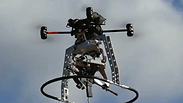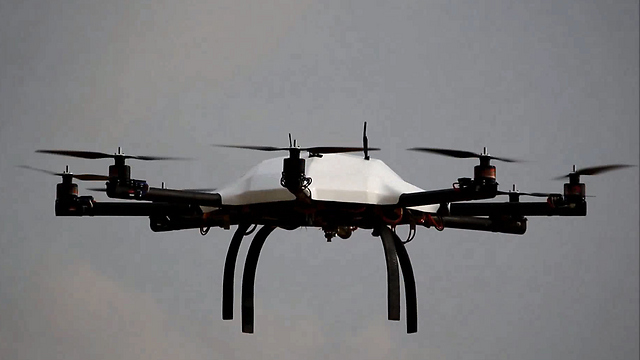
The Administration for the Development of Weapons (ADW) at the Ministry of Defense unveiled a number of state-of-the-art military developments Tuesday set to roll out into IDF service within the next few years on land, sea and air.
All the new armaments are based on advanced technology expected to revolutionize the way in which the IDF handles future clashes with Hamas or Hezbollah.
Among the new developments showcased were the Carmel armored transport—which will be available in the form of a tank, APC and heavy engineering vehicle—,a drone shooting small-arms fire from the air, a smart gun discharging only after locking onto a target and unmanned submarines for intelligence gathering and mapping.
These new armaments are all in the advanced stages of planning, and some—such as the smart rifle—have even been handed over the IDF, but they have yet to be declared operational. A prototype of others—such as the Carmel tank—will only be available in three years' time.
Further ADW developments that have yet to be presented to the public are "Fast", a system dispersing thousands of minute, covert sensors from the air over enemy territory in order to hermetically control it intelligence-wise, and the "Sky Eye", a drone autonomously scanning an area 10 square kilometers in size and enabling to reconstruct the area it has documented in a manner allowing the army to track down kidnappers' escape route.
An additional system enables shooting down enemy drones using a variety of offensive options: electronic warfare waves, laser beams or conventional fire. The Ministry of Defense is also developing real-time facial recognition technology, which is able to overcome two well-known obstacles: the targeting of wanted suspects walking among a crowd of people and trying to mask their features using a beard, hat and the like.
Unmanned submarines – UUVs
Despite the fact the lion's share of the Israeli Air Force's flight hours are taken up by unmanned aerial vehicles, the development of autonomous devices has yet to break through to the navy. In fact, the selection of unmanned naval instruments is scarce, and relatively limited. The small unmanned undersea vehicle, or UUV, is expected to change that. Other versions of this unmanned submersible already exist in the world, but now an Israeli version is being developed in tandem with Ben Gurion University.
The UUV is a miniscule sub used for scanning and mapping missions that may be launched from either the shore, a manned submarine or a ship. The UUV will then be able to dive in a rapid, almost vertical line, to move in any direction and—according to the Ministry of Defense—will cost a third of its international counterparts.
While work on the UUV is ongoing, a larger version is being developed, termed the "Little Caesar" ("Keysaron"), which is a true submarine for all intents and purposes, except for the fact it's unmanned. This large version will be used for covert operations such as information gathering.
Carmel – the tank of the future
After nearly 15 years of idle chatter and eventually-futile administrative work in the security establishment in the attempt to find a replacement for the massive and clunky Merkava tank, swapping it for a speedy armored vehicle more suited to the modern battlefield, a three-year plan got underway this year to develop the technological infrastructure for precisely that, an armored vehicle called the "Carmel."
This next generation armored carrier will be unrecognizable when compared to the Merkava tank and will be able to serve as a platform for both an APC or other heavy combat engineering tools, replacing the current wave of Puma armored engineering vehicle.
Similar to the current Merkava Mark IV, the Carmel will contain an active protection system in the style of the Trophy system, enabling it to shoot down anti-tank missiles, but it may not need to operate it at all. Under certain conditions, this APC will be able to turn "invisible" with a low signature "transparent armor" including an electric propulsion system against the enemy's radar systems, mostly at night. The Carmel will also have an unmanned version.
In either case, its engine will be silent, quick and hybrid, it will be smaller in size than the Merkava, operating it will be simpler and it will require only half the number of crewmen necessary to operate a modern-day tank: two instead of four. The pair of operators will be act almost like pilots, possibly with smart helmets creating simulations of the environment, and will not have to physically look out of the vehicle at all.
Their cabin will be surrounded by large touch-operated screens displaying everything the tank "sees" around it and presenting its course, using smart cameras and enemy detection systems.
The Carmel will be logged onto a network along with other tanks in the area, enabling it to automatically and spatially defend its entire convoy against missiles, rather than only itself.
The tank's mortars and machine guns will be operated using joysticks from the crew's cabin at unusual 60- and 80-degree angles, should the soldiers decide, for instance, to bombard a specific apartment of a high-rise building above them.
Development on the tank is expected to conclude in about three years. Some of its proprietary technologies, however, will be "exported" to the army as they are completed while development is still ongoing.
The firing drone
The IDF's testing laboratories is already putting one of the more advanced weapons of the future through the paces, expected to enter operations as early as this year.
This relatively small drones carries some small-arms system resembling a handgun or assault rifle and has accurate sniping abilities, surprising the enemy and preventing putting IDF soldiers in harm's way.
The Israeli startup company in charge of developing this device is slowly but surely overcoming some of its attendant challenges, such as stabilizing the drone before firing, safely yet silently operating it and achieving maximal accuracy for its shots.
The smart rifle – only fires if it's sure to hit target
ADW calls it the "smart shooter", but this development may bear any number of nicknames. It represents, without a doubt, a revolutionary new capability for the single infantryman on the battlefield.
A group of former Rafael Advanced Defense Systems employees developed an electro-optic system assembled over the army's assault rifles—the Tavor and the M16—intended to dramatically improve the chances of accurately hitting the target in all firing modes, emphasizing shooting after exertion and hitting with the very first shot, to prevent the target escaping if the shot misses.
The system actually marks the target itself and the smart trigger "prevents" discharge down to a split-second if the soldier is expected to miss. This ability should lessen the number of injuries to non-combatants. So far, testing of the system has gone well.
The Yasuron unmanned aircraft
Israel Aerospace Industries has developed an unmanned drone for ADW capable of flying up to 150 kmph and carrying up to 180 kilos, enabling it to carry logistical supplies such as ammo, water, fuel and food to our forces, nullifying the need to slowly and dangerously ferry them on the ground.
This drone-copter can reach 8 kilometers or more and carry out mission after mission using its internal combustion engine.
Aeronautics Defense Systems is concurrently developing a drone meant to serve a similar purpose, but using a battery-powered motor and hybrid propulsion, able to carry up to 90 kilos at a flight speed of 75 kmph.
This drone will be able to ferry special payloads for small concentrations of forces, at a low altitude, for tactical operations. After these two unmanned aerial vehicles have been presented and were able to fulfill missions, ADW is currently considering their continued development and usage.
Infantry robots and border defense using unmanned vehicles
Unmanned ground vehicles (UGVs) have been utilized in IDF operations for years, but have not seen widespread use—similarly to the navy's scant usage of unmanned vehicles.
One of the difficulties the army faces when operating UGVs in open terrain such as mountains or rocky outcrops is maintaining accurate fire capabilities. ADW is currently pushing through several UGVs simultaneously, some of which have already been handed over to the army.

These UGVs are utilized in a number of scenarios, such as land maneuvers for engineering or logistical tasks and infantry robots for urban warfare and routine security missions near the borders.
"We handle a variety of armament developments, including training dogs for the Oketz unit, instead of purchasing them abroad," explained the head of ADW Brig.-Gen. (res.) Dr. Daniel Gold. "We try to find solutions for forces handling a multitude of threats, from order disruptions to preserving land borders and rocket fire, breakthroughs in inter-war warfare (covert IDF actions to prevent Hezbollah and Hamas becoming stronger – ed.) and ending with total defense and offensive operational control of cyberspace."

















